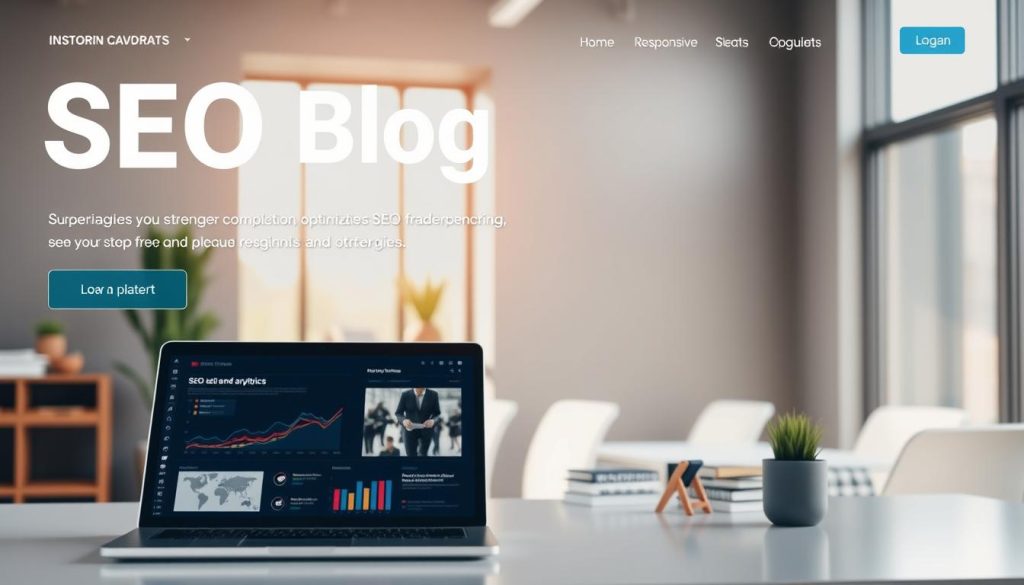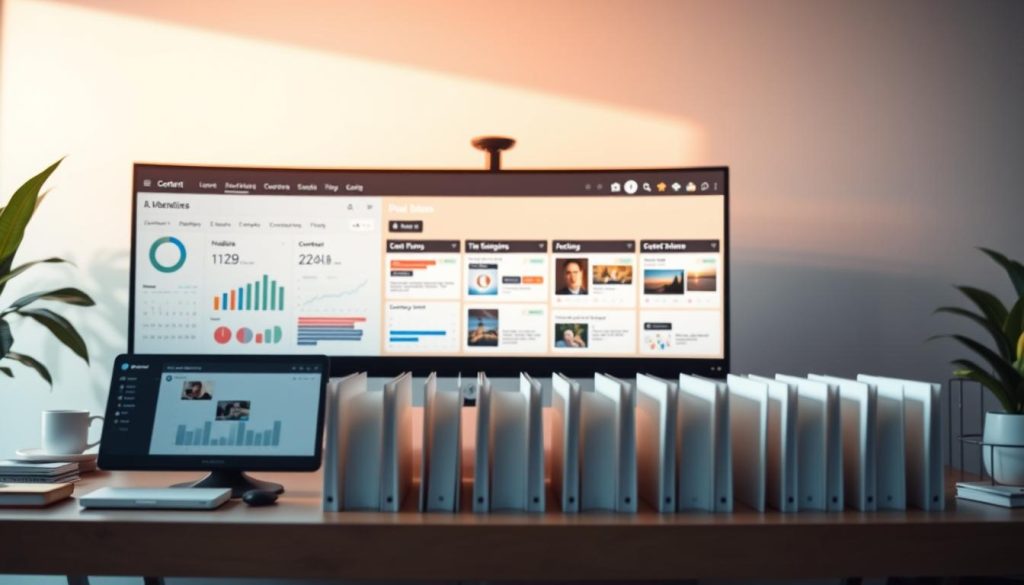Stop chasing cold leads and start attracting people who already want your skills. A steady stream of projects comes when your online presence is clear, consistent, and aimed at the right audience.
Think of your setup as a system: a trustworthy website, smart SEO, helpful blog posts, social posts that add value, and email notes that keep you top of mind. Each part helps prospects find and trust your brand.
Practical moves like blogging, guest posts, podcast appearances, and targeted social groups grow discoverability. Combine short-term wins (social, email) with long-term plays (SEO, case studies) to stabilize work volume.
We’ll walk through niche definition, building trust with real results, and tactics you can try this week. For social strategies and examples, see this guide on leveraging social media.
Table of Contents
Key Takeaways
- Shift from reactive to proactive: let your channels warm up clients before contact.
- View your presence as a system: website, content, platforms, and email all play a part.
- Mix quick wins (social, email) with compounding channels (blog, SEO).
- Use real proof—reviews and case studies—to reduce client risk.
- Measure traffic, engagement, and inquiries; iterate to improve results.
Start With Strategy: Define Your Niche, Ideal Clients, and Value Proposition
Start by narrowing your focus: a tight niche makes marketing simpler and more memorable. Specialists are easier to hire than generalists, so pick one industry segment and a small service mix.
Document your ideal client: business model, team size, budget, and the outcomes they care about. List their top questions, the platforms they use, and the main pains you solve.
Pick a focused niche to become the go-to expert
Choose one segment so people immediately grasp your expertise. Validate by scanning competitors and noting gaps you can fill with your skills.
Profile your ideal clients and their questions, platforms, and pain points
Map pains to offers and craft a clear value line: I help [industry] [audience] get [result] with [service]. Build quick proof: a case study, a how-to post, and a short explainer video.
| Action | Why it helps | First step |
|---|---|---|
| Define niche | Improves recall and search relevance | Pick one industry + service |
| Profile client | Targets messaging and offers | Document model, size, budget |
| Show expertise | Builds trust fast | Create case study + video |
Build Your Home Base: Website Essentials That Convert
Your website is the one place that must turn curiosity into contact. Top of page should show a one-line USP, a short explainer, and a clear CTA like Request a proposal. This reduces friction and tells people exactly what to do next.
Craft an impactful homepage
Show a short profile snapshot: friendly headshot, key credentials, and one standout metric. Add client logos, 1–2 short reviews, and a concise case highlight near the fold to build trust fast.
Create service pages optimized for search
Write pages using industry terms and clear deliverables. Outline scope, process, timelines, and pricing cues so people and search engines understand what you offer.
Design, speed, and domain matter
Use a custom domain, on-brand visuals, and mobile-first design. Make sure pages load quickly and include clear metadata, internal links, and schema for marketing gains.
Tip: If you need a step-by-step guide to build your site, follow this practical walkthrough.
Modern SEO and Blog Tactics for Sustainable Discovery
Good search results start with helpful, human-first posts that answer real questions.
Write for people first. Publish original perspectives, short case-backed insights, and tutorials that solve specific client problems. Layer SEO after the draft so the writing stays natural and useful.
Map topics to intent and build hubs
Make a topic map that covers « how to, » « cost, » and « case study » queries for your industry. Create a cornerstone hub like a « Complete Guide » and interlink related posts to send readers deeper into your site.
Republish and expand reach off-platform
Republish top posts on Medium and pitch to niche publications. Canonicalize originals to protect SEO and capture new audiences while keeping authority on your website.

Tip: Use short paragraphs, clear subheads, and internal CTAs that guide readers to a lead magnet or consultation.
| Focus | Action | Benefit |
|---|---|---|
| Human-first writing | Publish tutorials and mini case studies | Builds trust and dwell time |
| Topic map | Align posts to buyer intent | Improves relevance for clients |
| Off-platform | Republish on Medium | Expand audience and referrals |
For step-by-step SEO guidance tied to blog strategy, see effective SEO optimization.
Social Media That Brings Clients, Not Just Followers
Your social effort should create conversations that lead to work. Choose where to spend time by mapping platforms to client habits. Start small: one primary platform and one secondary for testing.
Select the right platforms
Pick LinkedIn for B2B, Instagram or TikTok for visual offers, and X for fast updates. Match the platform to the audience and the content you can produce well.
Post consistently with quality
Publish a mix: short tips, behind-the-scenes, curated industry news, and case highlights. Use carousels, Reels, Stories, and Lives to vary formats and keep people engaged.
Boost visibility and build relationships
Apply niche hashtags and local keywords (for France). Reply to comments, add thoughtful notes on others’ posts, and move promising chats to DMs to explore fit.
Quote: « Good social is about steady value, not hard selling. »
| Action | Why it works | Suggested cadence |
|---|---|---|
| Pick 1–2 platforms | Focuses effort where clients are | Start LinkedIn 3x/wk + Instagram 3x/wk |
| Mix content types | Keeps audience interested | Tips, BTS, news, case showcases |
| Use native features | Improves reach and discovery | Stories, Lives, Reels, carousels |
- Brand consistency: keep colors and tone steady so your profile is recognizable.
- Measure and iterate: save posts that lead to inquiries and repeat the formats that work.
Expand Your Reach in Groups, Forums, and Community Spaces
Join community spaces where real people ask real questions and expect honest answers. Groups on LinkedIn and Facebook, subreddits, and Quora are trusted places to share first-hand experience. Show up with useful, non-promotional replies and link to a resource only when it truly helps.
Start by listening: identify 5–8 communities where your audience posts questions. Observe norms, learn common threads, then answer with clear, step-by-step help.
- Schedule a weekly block to contribute and summarize lessons you see across threads.
- Build relationship capital by thanking moderators and adding complementary views from others.
- Use platform features—upvotes, marked answers, highlights—to boost visibility for your best posts.
Turn patterns into content: keep a log of recurring questions and convert them into short posts, a FAQ, or a blog article you can reference later. Repurpose high-value threads into carousels or short videos while crediting the community.
For more on active networking and community tactics, see develop your networking.
Create a Content System You Can Sustain Over Time
Treat each strong article as the seed for an entire campaign. This saves time and keeps your content consistent across channels. One blog post can become social posts, a short video, and a focused email that lands in inboxes.

Plan a simple editorial calendar
Build a 90-day calendar that links blog topics, social series, and email themes. This makes sure every effort reinforces core narratives and grows your presence steadily.
Use a repeatable production workflow
Brief → outline → draft → edit → publish → repurpose. Follow this so each piece reliably spawns posts, a teaser video, and one newsletter issue. Batch similar tasks to protect deep work time.
Tip: Choose realistic rhythms: one blog every two weeks, three social posts weekly, and a biweekly newsletter is a great way to start without burnout.
- Keep an ideas backlog from client calls and community threads.
- Add small productized offers like audits or templates to link content to products.
- Track effort vs. impact and review monthly to prune or double down.
Freelance Digital Presence: Trust Signals That Win Work
Trust signals are the short proofs that turn curious visitors into paying clients. Add clear, skimmable evidence across your site and profiles so people can verify your claims fast.
Collect reviews and recommendations. Ask every satisfied client for an outcome-focused review on Google and a LinkedIn Recommendation. Feature short quotes near the service they relate to.
Publish short case studies and experiments
Keep case studies to a one-page format: context, approach, and measurable results. Small experiments—like A/B testing a headline—make great blog posts and show real expertise.
Amplify UGC and mentions
Curate user-generated content, partner shout-outs, and media mentions. Reshare tags with a quick note on the collaboration to build authentic social proof without bragging.
- Proof section: add reviews, logos, and case links on your website so people can scan credibility.
- Visuals: use before/after images or annotated screenshots to highlight skills and results.
- Map proof to services: place 1–2 testimonials and a relevant case on each service page.
« Publish what you tested and what changed—transparency builds trust. »
Refresh proof quarterly and publish a short « What Clients Can Expect » page to reduce friction. For examples of visual portfolios and practical templates, see this guide on portfolio essentials.
Visibility Boosters: Podcasts, Collaborations, Guest Posts, and Events
Appear where people already spend attention: podcasts, niche blogs, and live events. These formats make your voice and ideas feel personal, and they fast-track trust with an engaged audience.
Pitch smart: build a compact pitch kit — bio, headshot, 3–5 talk topics with takeaways, and past appearances. Send tailored notes to shows and publications your target audience follows.
Make collaborations count
Co-host a webinar or hands-on workshop with a complementary pro. Split prep and promotion, record the session, then repurpose clips and a follow-up post as a lead magnet.
Choose events with intent
Attend conferences where clients and peers gather. One well-chosen event can generate referrals, partnerships, and direct work.
Quote: « Being on a podcast feels more personal than a blog post because listeners hear your voice. »
- Target guest posts in niche publications for higher conversion and link your contributor bio to a relevant case or service.
- Share social media recaps with actionable takeaways and tag hosts, speakers, and attendees to keep conversations alive.
- Track chance-to-inquiry: measure visits, emails, and discovery calls from each appearance and double down on what converts.
| Booster | Action | Top benefit |
|---|---|---|
| Podcasts | Pitch with short topics and audience-aligned angles | Personal reach and strong trust signal |
| Guest posts | Target niche outlets and link to relevant work | Higher conversion from readers to clients |
| Webinars & workshops | Co-host, record, repurpose | Leads + reusable content for social media |
| Conferences | Attend and present tactical sessions | Referrals and partner opportunities |
Simple process: batch outreach monthly, follow up once, and package a small product (like an audit) as the next step for new contacts.
Email and Paid Promotion: Stay Top-of-Mind and Scale Reach
Use email to land in inboxes and paid ads to speed up discovery for your best content. Newsletters let you appear at scale and build trust with an audience that already follows your work.
Start a value-packed newsletter; grow with lead magnets
Launch a simple newsletter that gives one actionable idea, one short insight, and one helpful link. Offer a checklist or template as a lead magnet so sign-ups match your services and website visitors turn into warm prospects.
Test paid ads on best-performing content
Boost posts that already get engagement on the right platform. Run small Google Ads for high-value blog pages and test Instagram or TikTok ads with a sharp hook for brand awareness.
- Segment lightly by industry or topic so people get relevant mail and you see more replies from new clients.
- Test 2–3 creatives, retarget site visitors with a soft CTA, and keep budgets modest until cost-per-lead stabilizes.
- Include a clear email footer: who you are, services, and the easiest way to reply or book.
Tip: Verify and prune your list regularly to keep deliverability healthy and analytics meaningful.
Measure What Matters and Improve Your Online Presence
Measure a few meaningful metrics and stop chasing vanity numbers. Start with a simple scorecard you can update weekly. Track traffic from key channels, content engagement, newsletter replies, and inquiries from clients.
Track engagement, traffic, and inquiries; refine by analytics
Use native analytics—Facebook Insights, Instagram Insights, LinkedIn Analytics, and Twitter/X Analytics—for quick channel checks.
Combine these with Google Analytics for social-to-site traffic, Hootsuite for post engagement, and Brand24 for mentions and sentiment. Make sure UTMs are consistent so you can attribute which campaign or site link drove each consultation request.
Handle feedback professionally and iterate your messaging
Treat feedback as data. Thank the person, clarify the issue, and propose a reasonable next step.
Avoid public defensiveness. Move heated conversations to email or DMs to resolve them like a pro. Track time-to-first-response; responsiveness often wins the job over larger competitors.
« Review weekly for quick course-corrections and monthly for deeper insights. »
- Scorecard: traffic by channel, content engagement, newsletter replies, and client inquiries.
- Tools: Google Analytics, Hootsuite, Brand24 plus platform analytics.
- Cadence: weekly checks, monthly analysis, quarterly content audits.
- Tests: set simple hypotheses and run small experiments to improve results.
Summarize findings in a short monthly memo: what worked, what didn’t, and one test for next month. If you want to better know your clients better, use those insights to refine offers, site copy, and email follow-ups.
Conclusion
,When you link clear offers, useful content, and real proof, your online presence begins to compound into steady inbound work.
Start with a niche, build a credible website, publish human-first posts, and use social channels with intent. Add reviews, short case studies, and small experiments to cut risk for your audience and win the job.
Use podcasts, guest posts, webinars, and events to accelerate reach. Keep nurturing with email and modest paid boosts to stay visible between buying cycles.
Measure what matters, handle feedback quickly, and refine offers as signals appear. Pick one platform and one content format to maintain next week—momentum beats perfection.
Action: list three things you’ll change on your website and one collaboration you’ll pitch this month. With steady effort, your presence will attract better-fit clients and more enjoyable projects for your business.
FAQ
How do I choose a niche so I become the go-to expert?
Start by listing your strongest skills, industries you know, and problems you enjoy solving. Cross-check that with market demand on LinkedIn, job boards, and client questions. Pick a focused niche where your experience and outcomes match clear client pain points; narrow beats broad when you’re building credibility and search visibility.
What should my homepage include to convert visitors into clients?
Lead with a clear USP (what you do and who you help), a short list of services, social proof like client logos or testimonials, and an obvious contact method. Fast load times, mobile-friendly layout, and a custom domain make your site feel professional and trustworthy.
How often should I publish blog posts and social updates?
Aim for consistency you can sustain. Start with one solid blog post every two weeks and two to three social posts per week, then scale. Regularity matters more than volume; use an editorial calendar to plan themes and repurpose content across channels.
What are “cornerstone” articles and why do they matter?
Cornerstone articles are long, in-depth posts that answer core client questions and link to related content. They help search engines understand your expertise and guide readers through your services. Interlink shorter posts back to these pillars for better discovery.
Which social platforms should I focus on to find clients?
Choose platforms where your ideal clients spend time. For B2B, prioritize LinkedIn. Creative services do well on Instagram and TikTok. X (formerly Twitter) is good for thought leadership and quick updates. Test two platforms first and double down on the best performers.
How can I turn one blog post into multiple pieces of content?
Break the post into social excerpts, short videos, an email newsletter issue, and a carousel or thread. Convert key stats or quotes into visuals. Repurposing extends reach without creating new research from scratch.
What counts as credible trust signals on my site?
Client testimonials, case studies with measurable results, Google and LinkedIn reviews, and clear contact details all boost trust. Real names, specific outcomes, and links to live work make proof more convincing to potential clients.
How do I approach podcast or guest post pitches?
Research shows and blogs that match your niche, then pitch a concise idea that benefits their audience. Include a short bio, three topic hooks, and past samples or links. Personalize every outreach—hosts respond to pitches that show familiarity with their content.
Should I use paid ads before building an email list?
Use ads to amplify high-performing content or lead magnets once you have a clear offer and landing page. Ads are costly without a follow-up system; build a value-packed newsletter first so paid traffic converts into engaged leads.
What metrics should I track to improve my online visibility?
Track website traffic, referral sources, engagement (comments, shares), lead inquiries, and conversion rate from contact to client. Qualitative feedback—client questions and common objections—helps refine messaging and services.
How do I gather useful reviews and recommendations?
Ask satisfied clients for short, specific testimonials right after deliverables or milestones. Provide a template to make it easy and request permission to publish on your site and LinkedIn. Follow up politely if they forget.
How can I engage in groups and forums without sounding promotional?
Share helpful, specific answers and case examples that solve people’s problems. Use a neutral bio link and avoid hard sells. Over time, consistent value builds recognition and inbound leads from community members.
What should be on my service pages to rank for industry keywords?
Describe clear outcomes, list specific services, include client results or brief case studies, and use relevant industry terms naturally. Fast load speeds, descriptive headings, and a straightforward contact CTA help conversions and SEO.
How do I handle negative feedback or a bad review professionally?
Respond promptly, acknowledge the issue, and offer to take the conversation offline to resolve it. Public displays of accountability and fixes often reassure future clients more than silence or defensiveness.
How much time should I spend weekly on marketing vs client work?
Aim for a split that keeps new leads flowing—start with 20–30% of your time on marketing (content, outreach, follow-up) and 70–80% on client delivery. Adjust as your pipeline stabilizes; early investment in marketing shortens the path to steady clients.





